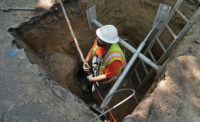'Below-Grade Guy' Rises on Innovation
George Tamaro earns ENR New York’s Legacy Award for advancing slurry-wall construction and foundation design

On the Job Tamaro oversaw efforts to stabilize the critical “bathtub” foundation at the World Trade Center after the 9/11 attack. He was also key in its original construction in the 1960s. Photos Courtesy of George Tamaro

On Tap After retiring from Mueser Rutledge in 2006, Tamaro has served as a consultant and industry expert. Photos Courtesy of George Tamaro

Up High and Down low: Tamaro worked on the design of the George Washington Bridge’s second deck in the 1960s, and in a circular slurry wall cofferdam at the Ignatius Caruso pump station in east Boston in 1990. Photos Courtesy of George Tamaro

Up High and Down Low: Tamaro worked on the design of the George Washington Bridge’s second deck in the 1960s, and in a circular slurry wall cofferdam at the Ignatius Caruso pump station in east Boston in 1990. Photo Courtesy of George Tamaro

From Student to Teacher Tamaro worked with noted architect Pier Luigi Nervi in Rome in the early 1960s. Photos courtesy of George Tamaro

From Student to Teacher Tamaro leads a World Trade Center site recovery meeting in 2001. Photos courtesy of George Tamaro






Steep tuition and vertigo steered George J. Tamaro away from architecture and high-rise engineering, so he went underground—becoming one of construction’s most accomplished “below-grade guys” in a 50-plus-year career in New York and globally as a foundation engineer and geotechnical building expert.
“Economics directed me to civil engineering at Manhattan College, which was the best decision that I could ever have made,” he said in an American Society of Civil Engineers interview last year. The impacts of his engineering instincts and innovative thinking on countless projects are largely out of public view, but they have pushed the technological needle far forward.
A partner for more than 20 years at New York City-based Mueser Rutledge Consulting Engineers until his 2006 retirement, Tamaro, now a consultant, began his career as a staff engineer at the Port Authority of New York and New Jersey in 1961 as it began planning the massive World Trade Center in lower Manhattan—a project that would define his career.
While on a fellowship in Rome to study reinforced concrete design with architect Pier Luigi Nervi, Tamaro was first introduced to slurry walls—a technique used to build reinforced concrete walls in areas of soft earth that are close to open water or with a high groundwater table. With the trade center being built on landfill next to the Hudson River, Tamaro grew to become a key expert on slurry wall technology—with patents in the U.S. and Canada for soldier beam and concrete lagging construction. Prior to joining Mueser Rutledge, Tamaro also was vice president and chief engineer at ICOS Corp., building his slurry wall expertise on global project foundations and expanding the use of the technology through lectures and articles.
Tamaro’s signature role came in engineering the original World Trade Center’s “bathtub”—a nine-block area excavated 70 ft down to bedrock and ringed by a slurry wall to serve as a dam against water seepage. At the time, “the scale of the project was unprecedented,” Tamaro says in a National Academy of Engineering project history. “This was only the third time slurry walls were used in the U.S. and one of the earliest uses of a large number of tieback anchors to such high capacities.”
Years later, at Mueser Rutledge, he would once again find himself at the forefront of that site—after the 9/11 terror attack destroyed the complex in 2001 and he joined first responders to stabilize the bathtub and insure its structural integrity. Tamaro told ENR in 2002 that the destruction left him “intellectually numb.”
“George became a national hero in 2001 when he led technical work on the World Trade Center’s below-grade recovery effort,” says Peter Deming, a Mueser Rutledge partner. Over many months, Tamaro “personally coordinated structural analysis with field conditions to support the perimeter slurry wall and heavy construction equipment for safe debris removal,” says Deming.
Tamaro also “designed the watertight plugs closing the [Port Authority Trans Hudson] tunnel openings and dewatered the site to secure the bathtub he helped build,” Deming adds. Tamaro recalls that books of site drawings developed by Mueser Rutledge became hot commodities for emergency personnel.
While engineering challenges also required Tamaro’s input on New York projects as varied as the second deck of the George Washington Bridge and hyperbolic paraboloid thin-shell umbrella roofs at Newark Airport terminals—among many others worldwide—the trade center “original construction and recovery will always be the pinnacle of my career,” Tamaro says. Ever resourceful and realistic, “you don’t need all the paperwork to do a job,” he told PBS in a post-9/11 interview. Numerous industry awards reinforce his decades of contribution to design and construction innovation.
Tamaro says that each point in his career allowed him to see things from a different perspective: “I worked as an owner’s engineer, as a contractor and as a consulting engineer.” His greatest challenges have involved “keeping a balanced outlook,” he says. “As part of their development as professionals, geotechnical engineers should be required to work on structural projects, while structural engineers should be required to work on geotechnical projects,” he told ASCE. “Structures in and on the ground will interact with the soil; engineers should do likewise.” Tamaro is a longtime teacher and mentor in his own firm, at his academic alma maters and elsewhere.
Says Deming, a 37-year Mueser Rutledge veteran who introduced Tamaro at ENR New York’s Legacy Award breakfast on Nov. 20: “His consulting and design projects changed construction of deep foundations in America.”











